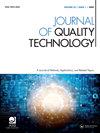Use of the bias-corrected parametric bootstrap in sensitivity testing/analysis to construct confidence bounds with accurate levels of coverage
IF 2.2
2区 工程技术
Q2 ENGINEERING, INDUSTRIAL
引用次数: 0
Abstract
Abstract Sensitivity testing often involves sequential design strategies in small-sample settings that provide binary data which are then used to develop generalized linear models. Model parameters are usually estimated via maximum likelihood methods. Often, confidence bounds relating to model parameters and quantiles are based on the likelihood ratio. In this paper, it is demonstrated how the bias-corrected parametric bootstrap used in conjunction with approximate pivotal quantities can be used to provide an alternative means for constructing bounds when using a location-scale model. In small-sample settings, the coverage of bounds based on the likelihood ratio is often anticonservative due to bias in estimating the scale parameter. In contrast, bounds produced by the bias-corrected parametric bootstrap can provide accurate levels of coverage in such settings when both the sequential strategy and method for parameter estimation effectively adapt (are approximately equivariant) to the location and scale. A series of simulations illustrate this contrasting behavior in a small-sample setting when assuming a normal/probit model in conjunction with a popular sequential design strategy. In addition, it is shown how a high-fidelity assessment of performance can be attained with reduced computational effort by using the nonparametric bootstrap to resample pivotal quantities obtained from a small-scale set of parametric bootstrap simulations.在灵敏度测试/分析中使用偏差校正参数自启动来构建具有准确覆盖水平的置信界限
灵敏度测试通常涉及小样本设置的顺序设计策略,提供二进制数据,然后用于开发广义线性模型。模型参数通常通过极大似然方法估计。通常,与模型参数和分位数相关的置信界限是基于似然比的。在本文中,它证明了偏差校正参数bootstrap与近似关键量一起使用,可以用来提供一种替代方法,用于在使用位置尺度模型时构建边界。在小样本设置中,由于估计尺度参数的偏差,基于似然比的边界覆盖通常是反保守的。相比之下,当序列策略和参数估计方法有效地适应(近似等变)位置和尺度时,由偏差校正参数自举产生的边界可以在这种设置中提供准确的覆盖水平。一系列模拟说明了在小样本设置中,当假设一个正常/概率模型与一个流行的顺序设计策略相结合时,这种对比行为。此外,还展示了如何通过使用非参数自举来重新采样从一组小规模参数自举模拟中获得的关键数量,从而减少计算工作量,从而获得高保真的性能评估。
本文章由计算机程序翻译,如有差异,请以英文原文为准。
求助全文
约1分钟内获得全文
求助全文
来源期刊

Journal of Quality Technology
管理科学-工程:工业
CiteScore
5.20
自引率
4.00%
发文量
23
审稿时长
>12 weeks
期刊介绍:
The objective of Journal of Quality Technology is to contribute to the technical advancement of the field of quality technology by publishing papers that emphasize the practical applicability of new techniques, instructive examples of the operation of existing techniques and results of historical researches. Expository, review, and tutorial papers are also acceptable if they are written in a style suitable for practicing engineers.
Sample our Mathematics & Statistics journals, sign in here to start your FREE access for 14 days
 求助内容:
求助内容: 应助结果提醒方式:
应助结果提醒方式:


